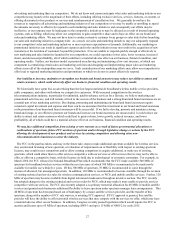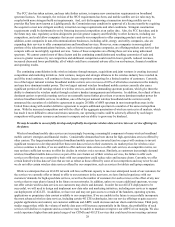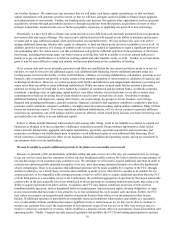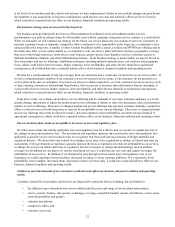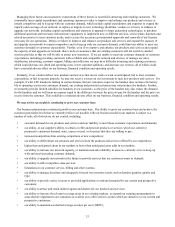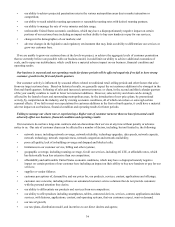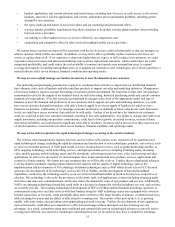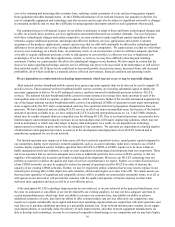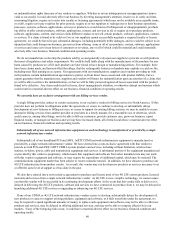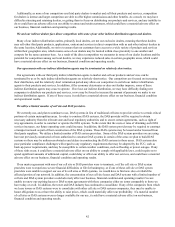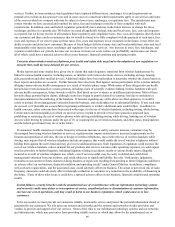Metro PCS 2011 Annual Report Download - page 47
Download and view the complete annual report
Please find page 47 of the 2011 Metro PCS annual report below. You can navigate through the pages in the report by either clicking on the pages listed below, or by using the keyword search tool below to find specific information within the annual report.36
over us by retaining and increasing their customer base, realizing certain economies of scale, and receiving greater support
from equipment and other manufacturers. As the CDMA infrastructure of our network becomes less popular or obsolete, the
cost of compatible equipment and technology may also increase and we may also be subject to significant write-offs or changes
in estimated useful life and we may have difficulty securing upgrades and improvements in such equipment when needed.
Our continued success will depend, in part, on our ability to anticipate or adapt to these and future technological changes and
to offer, on a timely basis, products, services, applications and content that meet our customer demands. For us to keep pace
with these technological changes and remain competitive, we may continue to make significant capital expenditures in our
networks, acquire additional spectrum, and design and offer new products, services, applications and content. Customer
acceptance of the products, applications, content, and services that we offer will continually be affected by technology-based
differences in our product and service offerings and those offered by our competitors. We cannot assure you that we will obtain
access to new technology on a timely basis, on satisfactory terms, or on our spectrum, or that we will have adequate spectrum,
or be able to acquire additional spectrum, or able to add capacity to our networks, to offer new services or implement new
technologies. If we do not offer these applications, content, or services, we may have difficulty attracting and retaining
customers. Further, we cannot predict the effect of technological changes on our business. We also cannot be certain that the
choices we make regarding technology and new service offerings will prove to be successful in the marketplace or will achieve
their intended results. All of these factors could lead to decreased growth, decreased revenues, increased churn, and decreased
profitability, all of which could have a material adverse effect on our business, financial condition and operating results.
We are dependent on certain network technology improvements, which may not occur or may be materially delayed.
Most national wireless broadband mobile carriers have greater spectrum capacity than we do that can be used to support 3G
and 4G services. These national wireless broadband mobile carriers currently are investing substantial capital to deploy the
necessary equipment to deliver 3G or 4G enhanced services, and have invested in additional spectrum to deliver 4G LTE
services. The national wireless broadband mobile carriers in many instances on average have more spectrum in each of the
metropolitan areas in which we operate, or plan to operate, which may increase further if the recently announced acquisition by
one of the largest national wireless broadband mobile carrier of an additional 20 MHz of spectrum in most major metropolitan
areas is approved by the FCC and is consummated, and may have spectrum with better propagation characteristics than our
spectrum. We have deployed and are selling 4G LTE services in all of our major metropolitan areas, but because of the limited
amount of spectrum available to us, we have deployed 4G LTE in selected metropolitan areas on 1.4, 3 and 5 MHz channels,
which may be smaller channels than our competitors use for offering 4G LTE. Due to our limited spectrum, our networks have
limited capacity and continued capacity increases in our metropolitan areas will require engineering solutions, which may not
work as anticipated, or which may take longer to deploy than anticipated. As a result, we are dependent on technology
improvements to continue to grow and service the demands of our customers. We currently are dependent on a limited number
of infrastructure and equipment providers to assist us in the development and deployment of our 4G LTE network and to
manufacture equipment for use on our network.
Our limited spectrum may require us to lease more cell sites to provide equivalent service, spend greater capital compared to
our competitors, deploy more expensive network equipment, such as six-sector antennas, make more extensive use of DAS
systems, deploy equipment sooner, redeploy spectrum from 4G LTE to CDMA or EVDO, require us to be more reliant on
traffic management tools and solutions, or make us more dependent on technological development, than our competitors. There
can be no assurance that we can lease adequate tower sites or additional spectrum, have access to DAS systems, or that our
suppliers will undertake the necessary and timely technological developments. Moreover, our 4G LTE technology may not
perform as expected or deliver the quality and types of services or performance we expect. Further, as a result of increased use
of our CDMA networks, we may be required to reduce the amount of spectrum used for 4G LTE in order to increase the
capacity of our existing CDMA networks. Further, we may be required to deploy solutions that we may need to replace in our
network prior to being able to fully depreciate such solutions, which could require us to take write-offs. We cannot assure you
that necessary quantities of equipment and compatible devices will be available on commercially reasonable terms, or at all, or
will operate on our network or will provide the customer with the quality and quantity of features desired, nor that when
delivered such equipment and devices will be at cost-effective prices.
If the anticipated 4G LTE technology improvements are not achieved, or are not achieved in the projected timeframes, or at
the costs we anticipate or can afford, or are not developed by our existing suppliers, we may not have adequate spectrum in
certain metropolitan areas, which may limit our ability to increase our customer base, may inhibit our ability to achieve
additional economies of scale, may limit our ability to offer certain products and services offered by our competitors, may
require us to spend considerably more capital and incur more operating expenses than our competitors with more spectrum, and
may force us to purchase additional spectrum at a potentially material cost. If our network infrastructure vendors do not supply
such improvements, or materially delay the delivery of such improvements, and other network equipment manufacturers are
able to develop such technology, we may be at a material competitive disadvantage to our competitors and we may have higher



